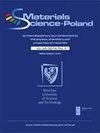聚乳酸的非等温熔化和冷结晶、熔化过程以及光学和机械性能:TAPH 的影响
IF 1.3
4区 材料科学
Q4 MATERIALS SCIENCE, MULTIDISCIPLINARY
引用次数: 0
摘要
我们通过酰化和胺化合成了一种新的苯乙酰肼衍生物(TAPH),用于制备改性聚乳酸(PLLA)材料。研究了改性聚乳酸的非等温熔融结晶和冷结晶、熔融过程、光学和机械性能,目的是将 TAPH 与聚乳酸的结晶和其他性能联系起来。非等温熔融结晶显示,TAPH 作为一种异质添加剂能够促进聚乳酸的结晶并加快其结晶速度。遗憾的是,冷却过程中冷却速率的增加会导致结晶能力下降。非等温冷结晶结果表明,PLLA/TAPH 的冷结晶行为取决于加热速率;在给定的加热速率下,随着 TAPH 添加量的增加,冷结晶峰向低温侧移动,进一步证实了 TAPH 的成核效应。PLLA/TAPH 的熔化过程有效地依赖于 TAPH、加热速率以及之前的结晶行为,包括非等温结晶和等温结晶。此外,熔化过程中出现的双熔峰被认为是熔化-再结晶所致。在光学特性方面,TAPH 对聚乳酸透明度的影响极为不利,2 wt% 的 TAPH 会导致聚乳酸的透明度为零。机械性能对比研究表明,TAPH 可提高 PLLA 的拉伸模量和拉伸强度,但任何 PLLA/TAPH 的断裂伸长率均低于纯 PLLA。本文章由计算机程序翻译,如有差异,请以英文原文为准。
Non-isothermal melt- and cold-crystallization, melting process, and optical and mechanical properties of PLLA: the effect of TAPH
We synthesized a new phenylacetic hydrazide derivative (TAPH) by acylation and amination to prepare modified poly(L-lactide) (PLLA) materials. The non-isothermal melt- and cold-crystallization, melting process, optical and mechanical properties of modified PLLA were studied with the objective of correlating TAPH to PLLA crystallization and other performances. Non-isothermal melt crystallization showed that TAPH as a heterogeneous additive was able to promote crystallization and accelerate the crystallization rate of PLLA. Unfortunately, an increase in the cooling rate during cooling led to a decrease in crystallization ability. Non-isothermal cold-crystallization results disclosed that PLLA/TAPH’s cold-crystallization behavior depended on the heating rate; and upon a given heating rate, with an increase in TAPH loading, a shift toward the low-temperature side of the cold-crystallization peak further confirmed the nucleation effect of TAPH. The melting processes of PLLA/TAPH effectively depended on TAPH, the heating rate, and previous crystallization behaviors including non-isothermal crystallization and isothermal crystallization. Additionally, the double-melting peaks that appeared during the melt were thought to be due to melting-recrystallization. In terms of the optical property, the influence of TAPH on PLLA’s transparency was extremely negative as 2 wt% TAPH caused PLLA’s transparency to be zero. A comparative study on mechanical properties showed that TAPH could enhance PLLA’s tensile modulus and tensile strength, but elongation at break of any PLLA/TAPH was lower than that of pure PLLA.
求助全文
通过发布文献求助,成功后即可免费获取论文全文。
去求助
来源期刊

Materials Science-Poland
MATERIALS SCIENCE, MULTIDISCIPLINARY-
自引率
18.20%
发文量
18
期刊介绍:
Material Sciences-Poland is an interdisciplinary journal devoted to experimental research into results on the relationships between structure, processing, properties, technology, and uses of materials. Original research articles and review can be only submitted.
 求助内容:
求助内容: 应助结果提醒方式:
应助结果提醒方式:


